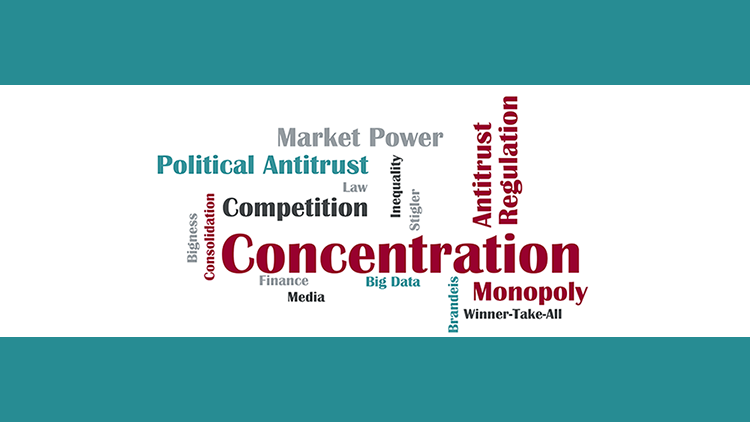In this installment of ProMarket’s interview series on concentration in America, Tommaso Valletti, the European Commission’s Chief Competition Economist, shares some thoughts on economic concentration of power in the U.S. and in Europe. “Competition authorities should invest in better understanding data markets.”
Does America have a concentration problem? On March 27-29, the Stigler Center hosted a first-of-its-kind, three-day conference in Chicago that focused on this very question.
The conference brought together dozens of top academics from law, economics, history, and political science, policymakers, journalists, and public intellectuals. Ahead of this conference, we presented influential scholars and thinkers with some questions on concentration, market power, and bigness—and their potential effects on the U.S. economy.
You can read all previous installments here.

Tommaso Valletti is the European Commission’s Chief Competition Economist. He is a Professor of Economics at Imperial College Business School and a Professor of Economics at the University of Rome Tor Vergata. His main research interests are in industrial economics, regulation, and telecommunications economics.
Valletti has held several editorial positions and published influential articles in top academic journals, and was a member of the panel of academic advisors of Ofcom, the U.K. communications regulator, as well as a member of the panel of academic advisors of the U.K. Competition Commission.
In an interview with ProMarket, Valletti shared some thoughts on concentration in the U.S. and Europe via email.
Q: The discourse on concentration, market power, and bigness in many U.S. industries has increased dramatically in the last year. Do you believe that we have enough empirical evidence to show that concentration is on the rise and having adverse effects on the economy? Do we see such trends also in Europe?
1. There is surprisingly little evidence on concentration trends in Europe. Moreover, concentration trends in markets are not straightforward to measure, and some important caveats about the empirical evidence should be mentioned:
-
-
Concentration indicators are typically available at higher levels of aggregation than antitrust markets (for example, industrial concentration measures pool several markets or, in the case of Europe, concentration indicators are typically national, even when antitrust markets are Europe-wide);
-
-
-
In general, such aggregation of markets can either increase or decrease observed concentration measures compared to the actual concentration in antitrust markets. Observed concentration will be higher at the available aggregate levels (e.g., NACE/ISIC industries) compared to the antitrust markets due to conglomerate mergers of complementary products. Conversely, concentration indices measured at national level will be lower than the concentration in antitrust markets if the latter are sub-national;
-
-
-
Concentration indicators are often not based on the sales on the market. For example, it can be that only production data is available. Production might have different geographical patterns than sales. Hence, with production data only, it might not be possible to approximate sales concentration tendencies at very granular geographical levels (country level data should be aggregated to the EEA level even if relevant markets are national).
-
2. We have some preliminary indications about concentration trends in Europe (based on production data): since the financial crisis, there is a subset of industries that show increasing concentration (although in some countries there are signs of significant de-concentration as well), but most of the national economies did not increase (or decrease) in concentration significantly.
3. Whether these trends are caused by market power is unclear. It follows that, at this stage, it is uncertain whether the observed increasing concentration in a subset of industries has adverse effects.
Q: In your opinion, what are the main reasons for the rise in concentration?
-
There are many possible explanations for increasing concentration (e.g., better performance of large firms, market power, financial constraints of SMEs, etc.). Currently, there is no systematic assessment of these causes for Europe.
-
Disentangling market power and efficiency effects would probably require plant-level data. See, e.g., Bloningen and Pierce, 2016, “Evidence for the Effects of Mergers on Market Power and Efficiency“, FRB Washington. Bloningen and Pierce find that in recent U.S. mergers the market power effect dominated, while efficiencies were not significant.
-
Another approach is ex-post studies. Here Kwoka’s meta-study on U.S. remedies can be of importance (finding a “too lax” U.S. merger enforcement policy), as well as the criticism that this research received.
-
At a conceptually and methodologically simpler level perhaps, first the industry concentration trends should be complemented with trends in profitability. Unlike in the U.S. case, there is still not a systematic description of these variables for Europe.((For the U.S., see, e.g., Grullon, Larkin and Roni, 2017, “Are U.S. Industries Becoming More Concentrated“, mimeo.))
Q: Which industries should we be concerned with when we look at questions of concentration? Do we have evidence of excessive market power, reduction in quality or investment, or growing political influence?
Though there are some efforts to conduct more systematic investigations into the topic of concentration trends, it is too early to say or indicate specific industries or markets.
Q: Has there been a significant difference in Antitrust policy in the EU compared to the U.S.?
We are not aware of any systematic comparisons. Of course, one has to first make the caveat that it is difficult to make a comparison because of the different institutional set-ups. There seems to be less visibility of the full scale of the U.S. enforcement activity, while for example all EC merger decisions are public. Having said that, there is a more or less clear perception that the EC is more active in antitrust (conduct) than the U.S. agencies.
Q: The five largest internet and tech companies—Apple, Google, Amazon, Facebook, and Microsoft—have outstanding market share in their markets. Are current antitrust policies and theories able to deal with the potential problems that arise from the dominant positions of these companies and the vast data they collect on users?
Though there are some past antitrust decisions related to technology firms (see, e.g., the EC’s Microsoft case), the antitrust implications of ‘big data’ are still not fully understood. But the interest is very real and the thinking is progressing around several factors:
1. There is no definite view on why and how big data might lead to competition policy issues. Moreover, it is also often acknowledged that big data can have positive and pro-competitive effects.
2. Personal data vs. big data:
-
-
-
With regard to personal data, the question has been raised by some whether a degradation of data protection could lead to exploitative concerns or could be seen as consumer harm in other cases. This raises the issue of the interaction of competition policy with other areas of law (data protection and privacy in this instance).
-
-
-
-
-
With regard to big data, the question is whether an accumulation of data in the hands of a company can constitute an insurmountable advantage and give rise to a competition case (whether a refusal to supply a case under article 102 or a merger case prohibiting or remedying such an accumulation of data).
-
-
3. Of course, the interaction of personal data, big data and competition policy is the subject of intense debate at the moment. Different stakeholders entered with different propositions and views into the debate.
-
-
-
Privacy advocates, for example, were turning to competition policy to promote privacy issues (though the new EU General Data Protection Directive of 2016 addresses much of the issues).
-
-
-
-
-
Tech firms, such as Microsoft, argued at some point that access to rival firms’ big data might be needed for certain business to “take off”.
-
-
-
-
-
Or telecom operators argued that swiftly and effectively accessing customer data might be beneficial to opening up or entering into some new markets.
-
-
4. Though there is no clear consensus on the antitrust debate, some points seem to emerge.
-
-
-
First, competition authorities should invest in better understanding data markets.
-
-
-
-
-
Second, competition law remains “fit for purpose” and has the tools and notions needed to tackle data markets.
-
-
-
-
-
Third, it can potentially be useful to explore the “value of transaction” test for merger thresholds.
-
-
Q: Is there a connection between the growing inequality and concentration, dominant firms, and winner-take-all markets?
-
The increase in income inequality, at least in the U.S., started much earlier than the rise of the large digital service provider companies, therefore it is not clear whether the current inequality would purely be the result of the increasing importance of these companies.
-
It is an open question, however, whether the shift of the economy in the last decade towards the digital sectors has contributed to strengthening the inequality tendencies.
-
One might even also consider whether concentration trends in general are just one of the many factors in the increasing income inequality. Economic trends in trade and labor markets, the changing industrial structure of national economies, as well as income redistribution can also be equally or maybe even more likely candidates to explain the increasing income inequality.
-
It is true, however, that some authors do attempt to link certain labor market tendencies and inequality trends to changes in industry structure and concentration. For example, Furman and Orszag (A Firm-Level Perspective on the Role of Rents in the Rise in Inequality, 2015) find that increases in income equality are associated with increases in dispersion of earnings across firms. According to them, (i) a rising share of firms are earning super-normal returns on capital; (ii) workers at those firms are both producing and sharing in those super-normal returns, driving up wage inequality; and (iii) the high returns to labor and capital at those firms reduce labor mobility by discouraging workers from leaving firms that earn higher rents.






